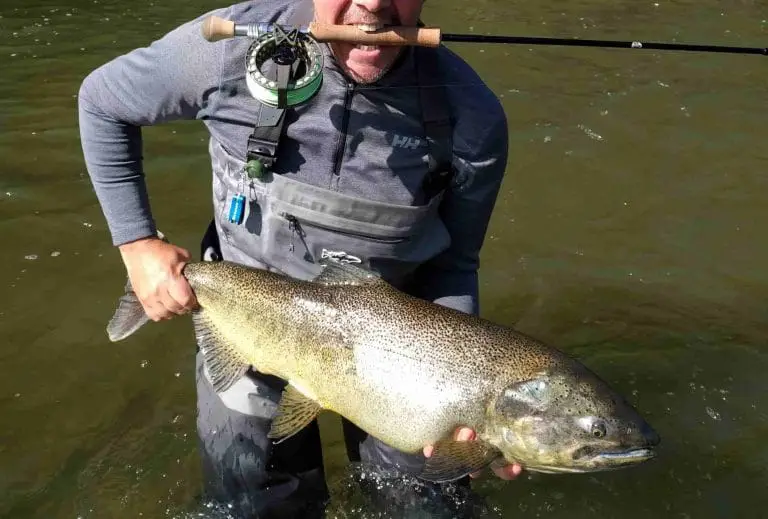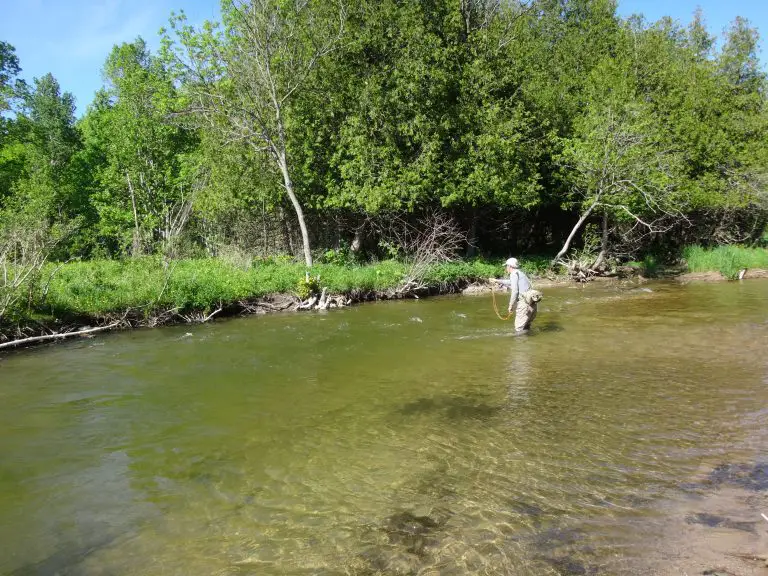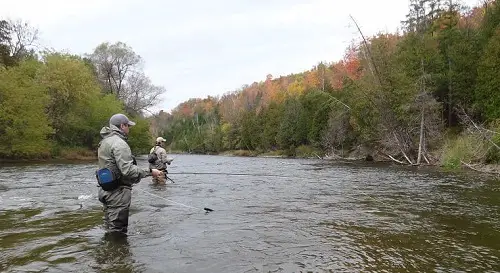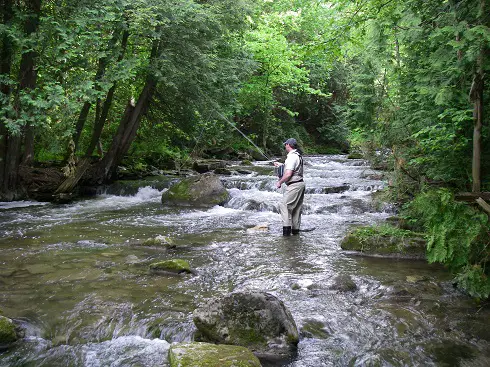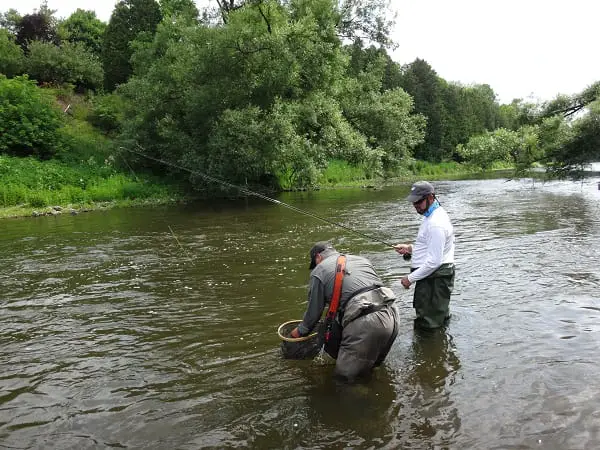Fly Fishing In Ontario: Advice From Ontario’s Top River Guide

Expert Advice On Fly Fishing In Ontario
This fly fishing in Ontario page is an all-about fly fishing guide for beginner to advanced anglers with tips and advice from Ontario’s top fishing guide. If fly fishing in Ontario is something you want to know about then you are in the right place.
Fly fishing in Ontario can mean a lot of things, but most anglers think of fly fishing for Ontario trout, steelhead, and salmon, and this page cover that the most. As a top river guide in Ontario, I know that fly fishing in Ontario can also be for other species as well.
Getting Started Fly Fishing In Ontario
Some anglers that are interested in fly fishing in Ontario might think that fly fishing is too confusing, too difficult, or too expensive, but once you understand the basics it’s actually pretty easy and it’s very fun and affordable.
I have taught thousands of beginner to advanced anglers how to fly fish and this is what I recommend and teach them when they are out with me on the water.
Learn To Fly Fish In Ontario Faster

It’s a lot easier and faster to learn how to fly fish if you have someone that can teach you.
A friend or relative that already knows about fly fishing in Ontario can be your best asset. They can give you on the river lessons that will shorten your learning curve.
Not everyone knows someone that fly fishes so using a river guide that teaches fly fishing for a living can help you not only dramatically increase your learning speed but can also save you a lot of money. Many of the top river and fly fishing guides can be found at A Perfect Drift Guide Company
What I mean by saving you money is that a guide can help you make the right decisions on what rods, reels, waders, lines, and all the other tackle you will need and that will likely save you from buying useless stuff or the wrong stuff.
But don’t worry, You won’t have to hire me to get gear advice because it’s right here on this website.
Not only can I help you get the right gear for fly fishing in Ontario, but when you learn from a guy like me you learn the right way to fly fish and not the wrong way.
I know not everyone can afford to take lessons from a fishing guide like me so I built this website to help out those new river anglers too.
I hope to continue to grow this website and add more information every year so check back regularly and don’t forget to connect with us on Instagram and on our Facebook page because I provide extra tips and advice that you may not see here.
Fly Fishing In Ontario At It’s Best
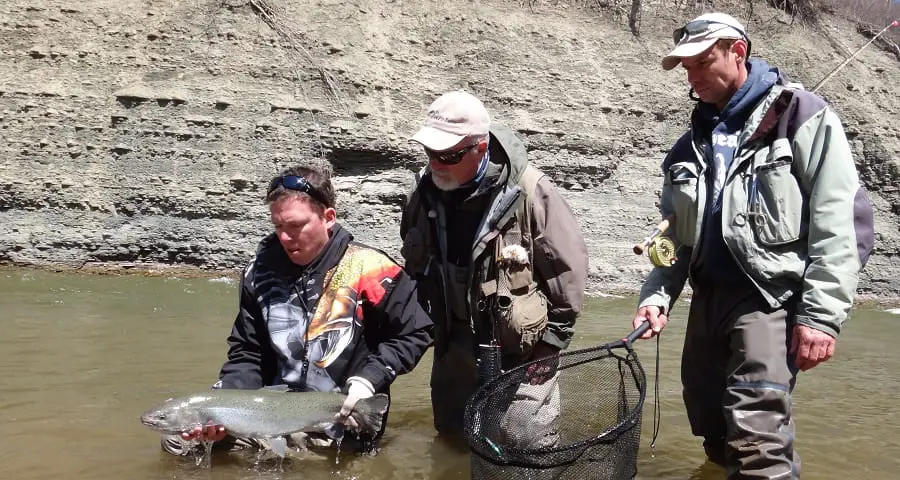
Fly Fishing can be one of the most productive and fun methods for catching fish on most small to mid-sized rivers.
The great thing about fly fishing in Ontario is that fly fishing can be great in Ontario and it can be productive for all river species including trout, salmon, bass, pike, musky, and steelhead like the one in the above picture which shows me, Bill and Mark of The New Fly Fisher Show catching steelhead on the Lower Credit River – Watch Show Here
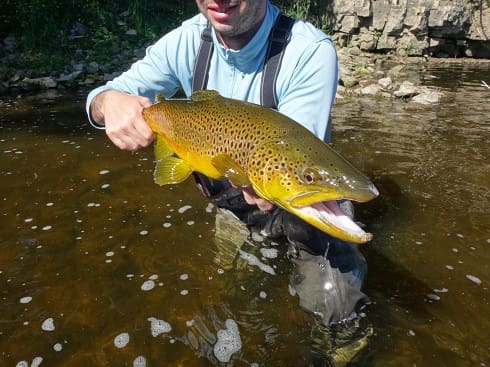
As a top river guide that guides with spinning rods and Centerpin rods and also who specializes in fly fishing in Ontario, I know there are times when fly fishing will out-fish all other methods.
Fly fishing excels in faster and shallow water when nymphing and it can’t be beaten in slower flat water when trout are rising up for flies on the surface.
During the summer months, I prefer to fish and guide with fly rods simply because they are the effective way to fish the low clear rivers in the summer.
The methods and gear I discuss on this page are not just for Ontario rivers because I have fished every state surrounding the great lakes as well as rivers in BC, and other parts of the USA, and the methods and gear recommended here have been effective everywhere.
When I go out with guides all around the great lakes and in BC they often use the same gear and same methods that I would use and often the only thing that changes are the type of flies they use or sometimes they may have a specific method that works best for their area.
For tips and advice on fly fishing methods including how to set up your leaders and lines, the best indicators, the best flies, and how to fly fish better check out my blog page on Fly Fishing at www.troutandsteelhead.net .
Ontario Fly Fishing Species
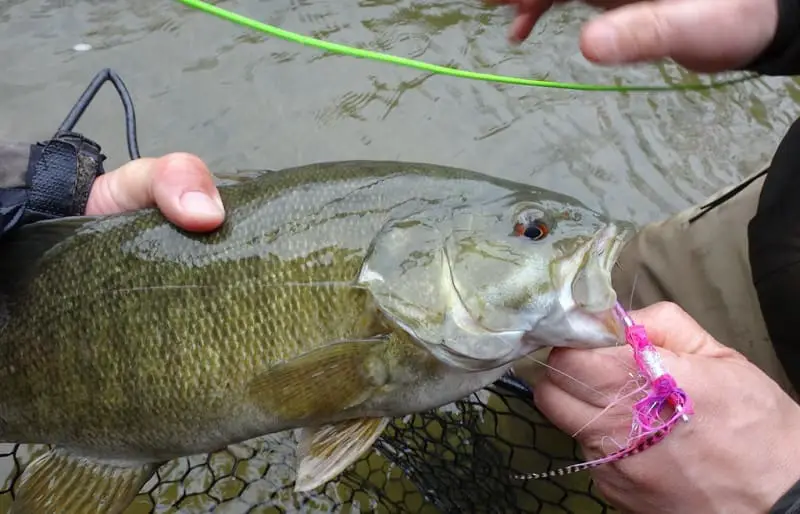
When some people think of fly fishing in Ontario they often think of just trout. In Ontario, our rivers have many other species that can be fished with a fly rod.
We have brook trout, brown trout, rainbow trout, salmon, and steelhead which are the most common river species to fly fish for in Ontario. Anglers could also fly fish in some rivers for large and smallmouth bass, musky, pike, walleye, panfish, and carp.
Bass is often a preferred river fish for fly fishing in the heat of the summer since they provide good fights and can be large and plentiful If you know where to go there is great trout fishing all summer.
River Musky and pike are also another challenging sport fish that is a blast on a fly rod, and fly anglers in Ontario have a few good options for these feisty fish.
The guides at A Perfect Drift Guide Company offer fly fishing trips for all of these warm-water species in the months of June, July, August, and September.
The three most common species to fly fish for are brown trout, brook trout, and Steelhead.
Steelhead fishing in the fall and spring can be fantastic and anglers can have days when they hook over 20 steelhead a day on a fly rod.
I teach anglers my methods and my fly fishing leader setups for steelhead in my article Fly Fishing For Great Lakes Steelhead.
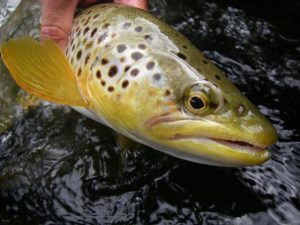
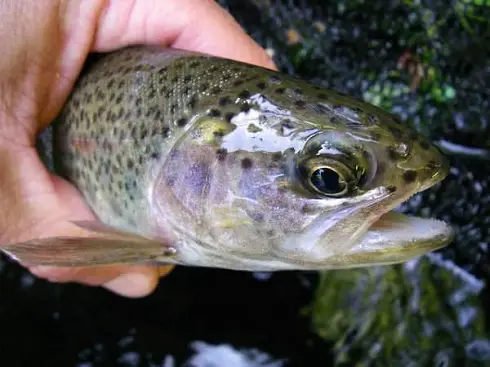
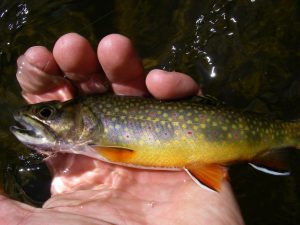
Ontario Fly Fishing Seasons And Times
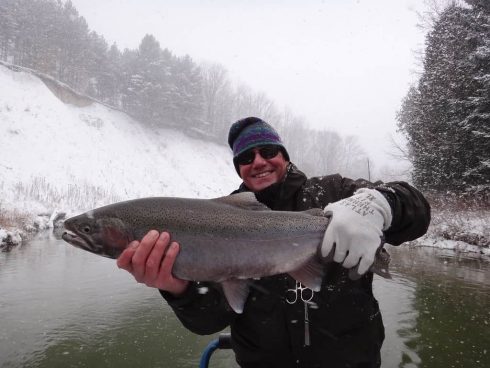
When is the best time for fly fishing in Ontario?
Ontario fly anglers have the ability to fly fish in Ontario 12 months of the year. The best time for fly fishing is usually from the opening day of trout season until the end of June, and then again for salmon and steelhead from September to December.
Ontario fly anglers have different seasons and different prime times for different species.
Even though most rivers would be closed for the season or would be frozen solid throughout January and February, some die-hard anglers can usually find somewhere to fish thanks to extended open season fishing regulations and some open water on rivers that may not freeze up.
Even in the coldest months, big rivers like the Niagara, the Saugeen, the Nottawasaga, and the Maitland river can often have open water where anglers can fly fish for steelhead. If fly fishing in the winter is something you want to try check out this page Fishing In The Winter – Stay Warm With These 10 Tips
You can see the extended season opportunities and year-round open seasons on the OMNR website. This picture shows an angler fly fishing in Ontario and reaping the rewards of dressing warm and fishing during the winter while on a guided trip with A Perfect Drift Guide Company
Summer Fly Fishing In Ontario
Where can you fly fish in Ontario during the summer?
Most rivers are open for fishing between the 4th Saturday in April to the last day in September and most rivers have trout and warm water species you can target in the summer.
Although the lower sections of many rivers will get too warm for trout, some anglers know that fishing way up the river in the headwaters of many rivers can still be very good all summer long. This is where the water temps can stay cold all day or at least be cold overnight and early in the morning.
I recommend buying a good stream thermometer and testing the waters to make sure you are not fishing water that is too warm and too stressful for the trout. For brown trout and rainbow trout, I recommend not fishing in water warmer than 68f/20celsius.
For brook trout, it’s wise not to fish in water warmer than 65f / 18celsuis.
I recommend good stream thermometers and a whole lot of other great gear on my page Best Gear For River Fishing.
Why a good thermometer? Not only do the fish often not feed when the water is too warm which means you will be just wasting your time, but fighting trout in water that is too warm can be stressful on the fish and can kill it.
If you test the water and see that it is too warm you can often move to colder water sections.
I guide all summer and sometimes the best fishing and the biggest trout my clients catch are in July and August even on the hottest days. July, August, and September are when the trout are at their biggest.
It’s also possible to have great trout fishing for a few hours early in the morning and then go fish for bass and pike later in the day further down the same river.
Anglers fly fishing in Ontario during the summer can also fish the many smaller colder creeks that stay cold all day.
Small Creek Fishing In Ontario
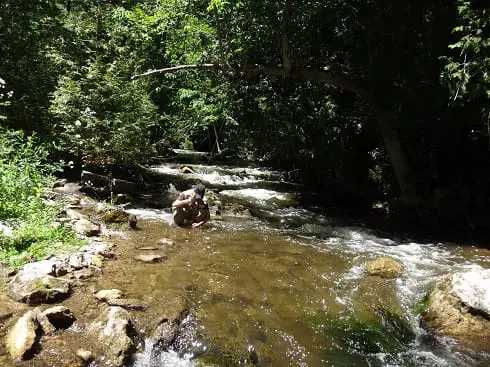
Another good idea for fly fishing in the summer is to search out the small tributary creeks that flow into the bigger trout rivers.
These smaller creeks can sometimes be ice cold and full of hungry trout including some very large trout that may have moved into these sections for the colder water.
The hard part is how bushy they can be making it more difficult to fish. With smaller 2 to 4 weight rods and light tackle, the fishing can be great, you just need to plan your cast more carefully so you’re not constantly stuck in the trees or grass.
Small rivers often have lots of brook trout in the 5 to 10-inch range and some will have brook trout up to 7 pounds. If you are interested in Brook trout fishing in Ontario check out my page Best Brook Trout Fishing In Ontario: Southern Ontario.
Many small creeks also have good brown trout fishing with some brown trout over 24″ in these small creeks. In fact, an 8-pound brown trout was caught about 1 kilometer upriver from the spot in the above picture. To learn more about brown trout fishing in Ontario and where the best brown trout rivers and creeks are, be sure to check out the Ontario Brown Trout page.
Fly Fishing In Ontario For Warm Water Species
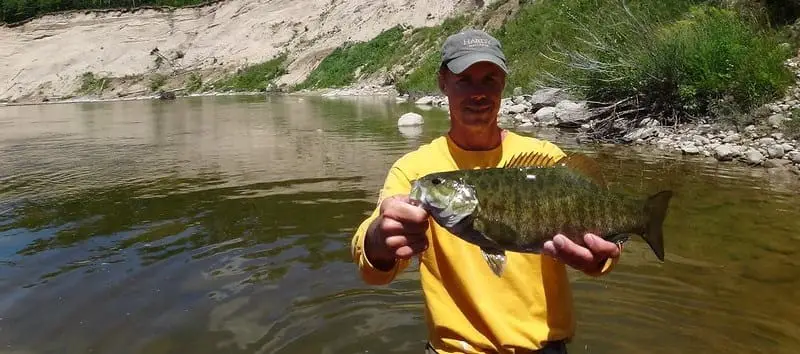
Fly fishing in Ontario during the summer can be excellent if you switch gears from trout, steelhead, and salmon and you start targeting warm-water species.
Fly fishing for small-mouth bass in the rivers can be tons of fun with large bass hitting flies below the surface and on the surface. You can also fish for large-mouth bass in ponds and lakes and also fly fish for pike, musky, and carp in both rivers and lakes.
Carp fishing can be excellent in the summer and these challenging and hard-fighting fish have been known to run 100 feet or more.
Other species that anglers can fish for are the garpike. These prehistoric-looking fish will take a well-presented fly. They can sometimes be found near the river mouths and in lakes.
Fly Fishing In Ontario In The Spring
Some of the best steelhead fishing in Ontario starts when the ice on the rivers starts breaking up and the snow starts melting. This can be a great time to start fly fishing in some of the year-round open sections of rivers.
The official trout season in Ontario opens on the 4th Saturday in April and the fishing for both steelhead and trout can be great for a few weeks. Once the steelhead leave the rivers fly fishing in Ontario means it’s time for resident trout like brook trout and brown trout and some rainbow trout.
Knowing when the runs are and what triggers the runs can really help you determine when the best fishing will be.
To learn more about when to determine the steelhead runs check out my page When Do The Steelhead Run In Ontario?
If you going to be fly fishing for steelhead, check out my page on the 5 Best Flies For Steelhead – An Expert Guides Advice. See at www.troutandsteelhead.net
Late spring is when our trout fishing starts and the months of late Aprile to Late June is the best time to be fly fishing and the best time to be able to fish the big hatches. Check out my page 11 Spring Trout Flies That Guides Actually Use. See at www.troutandsteelhead.net
Fly Fishing In Ontario In The Fall
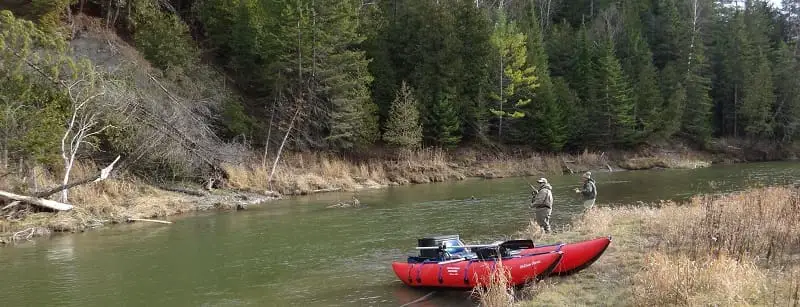
Early fall can be good for resident trout until the trout season ends on October 1st.
The brown trout and brook trout have been fattening up all summer and are starting to take on their fall spawning colors. The water is also starting to get cooler and more suitable for fishing.
The official trout season ends with the last day in September and as of October first, most anglers can fly fish extended fall and year-round open sections for salmon and steelhead.
This is a time when fly fishing in Ontario can be at its best. Fly anglers can catch Chinook salmon up to 40 pounds on a fly rod. They can also catch coho salmon, Atlantic salmon, migratory brown trout up to 30 pounds, and steelhead up to 30 pounds.
The guides at A Perfect Drift Guide Company will guide on some of the best rivers in Ontario and teach fly anglers how to catch these big migratory fish.
Fly Fishing In Ontario For Salmon In The Fall
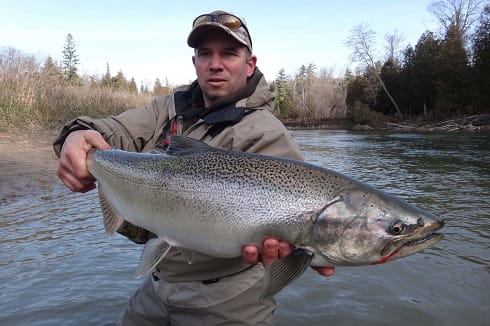
Fly fishing in Ontario can be great for salmon.
Fishing for Ontario river salmon can start as early as August on some rivers but the runs are small and sporadic and the water temperatures are not great for fishing these big fish.
The big runs of salmon start in early to mid-September.
When fly fishing for salmon, I use many of the same methods that use to catch steelhead. Anglers can nymph fish or swing flies for salmon.
The main difference is that you will want to up-size all your gear and leaders.
For more info on fly fishing for Ontario salmon check out my page Fly Fishing For Salmon.
Winter Fly Fishing In Ontario
Fly fishing in the winter is usually limited to steelhead fishing on sections of rivers that we are allowed to legally fish until December 31st or on some rivers that have open sections that anglers are allowed to fish on year round.
Steelhead fishing can be fantastic on rivers that are not frozen over during the winter. I have had clients land over 40 steelhead a day in the middle of January and February.
Make sure if you plan to do some fly fishing in the winter that you know how to dress properly. I discuss my methods for staying warm when winter fishing on my page Fishing In The Winter – Stay Warm With These 10 Tips. See at www.troutandsteelhead.net
Fly Fishing Methods
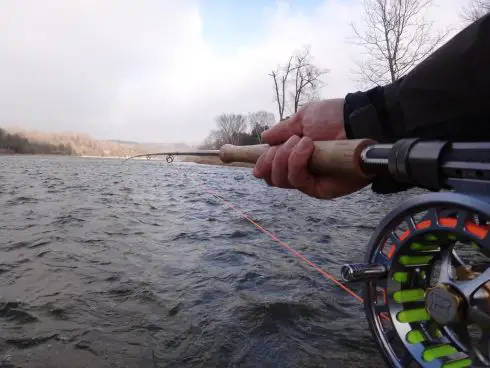
The 5 Methods of Fly Fishing: There are 5 methods used when fly fishing in Ontario for brook trout, brown trout, and rainbow trout.
Some of these methods will work for other species like steelhead and salmon.
These methods are:
- Dry Fly Fishing
- Wet Fly Fishing
- Nymphing
- Streamer Fishing
- Spey Fishing
With each method, there can be multiple variations which might include the weight or size of the set-up, the types of flies used, or even how you present your fly.
The variation you use may be due to the size of the river, the size of the fish, The time of the year or the water temperatures, or even just different feeding habits from one river to the next
There are so many different variations on each method that I can’t cover all that on one page so I will have an in-depth page for each method coming soon.
Dry Fly Fishing
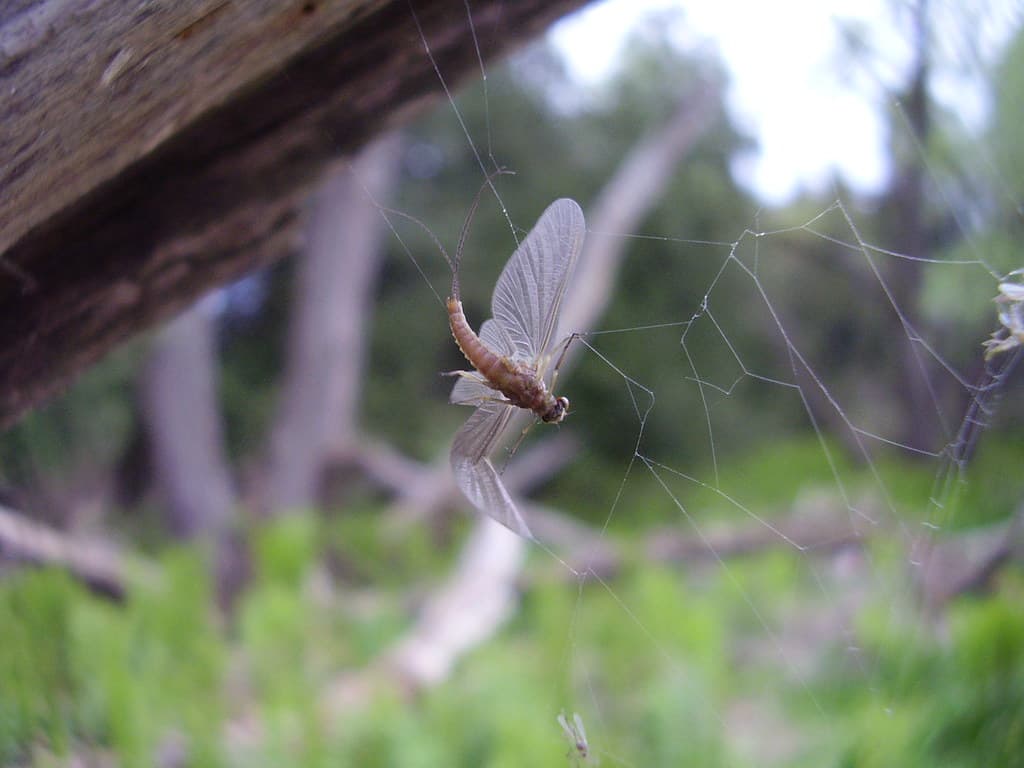
Dry Fly Fishing: Dry Fly fishing in Ontario is probably the most fun you can have with a fly rod and it’s the preferred method of many anglers. You can also fish bass, pan-fish, pike, and musky a dry fly.
Dry fly fishing basically means you’re presenting a floating fly pattern on the surface of the water to a trout that may be feeding on bugs that are floating on the surface or to entice a trout to come up to the surface to grab your fly. Check out this basic How to Dry Fly Fish Video for a better idea.
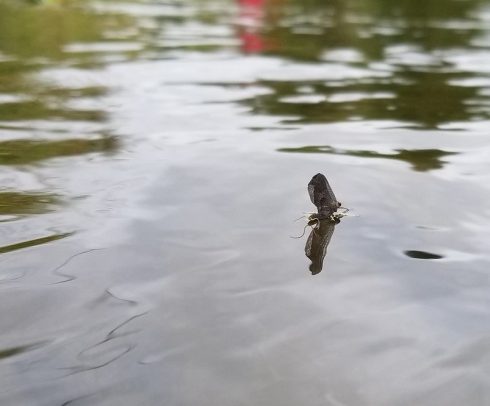
During the warmer months when the bugs are active, some trout will feed on the surface all day long.
Experts say and I agree that surface insects are generally only about 5% to 10% of a trout’s diet so getting lucky and being on the river when the trout are feeding on the surface isn’t always possible.
In Ontario, dry fly fishing usually starts around the first week in May and progressively gets better later in May and in June as the waters warm up.
Trout don’t feed as well on the surface when the water is very cold or getting colder but as the water warms they become more active and are more likely to rise up for a fly.
Many different insect species hatch during May and June so your chances are good but as the season progresses there are fewer and fewer bug hatches.
Using a good hatch chart can help you time the hatches better, check out this Ontario Hatch Chart for more details.
WHAT IS A HATCH
For my readers that don’t know what a hatch is, a hatch is a time when the river insects become active and are either emerging from the bottom and moving to the surface to eventually morph from Nymph to a flying adult.
The other reason a hatch occurs is when the mature adults are dropping to the surface of the water to drop their eggs into the water.
The basic life cycle is egg, nymph, adult dry fly. The hatches are based on time of year and water temps and can be very predictable.
I’ve often told clients in early May that the hatch for the Hendrickson Mayfly will be at 2 pm and that when the fishing will get really good at that time, and I’m often right.
Dry fly fishing can either be done using a dead drift method or with a twitching or skittering type of method that imparts a bit of action to the dry fly.
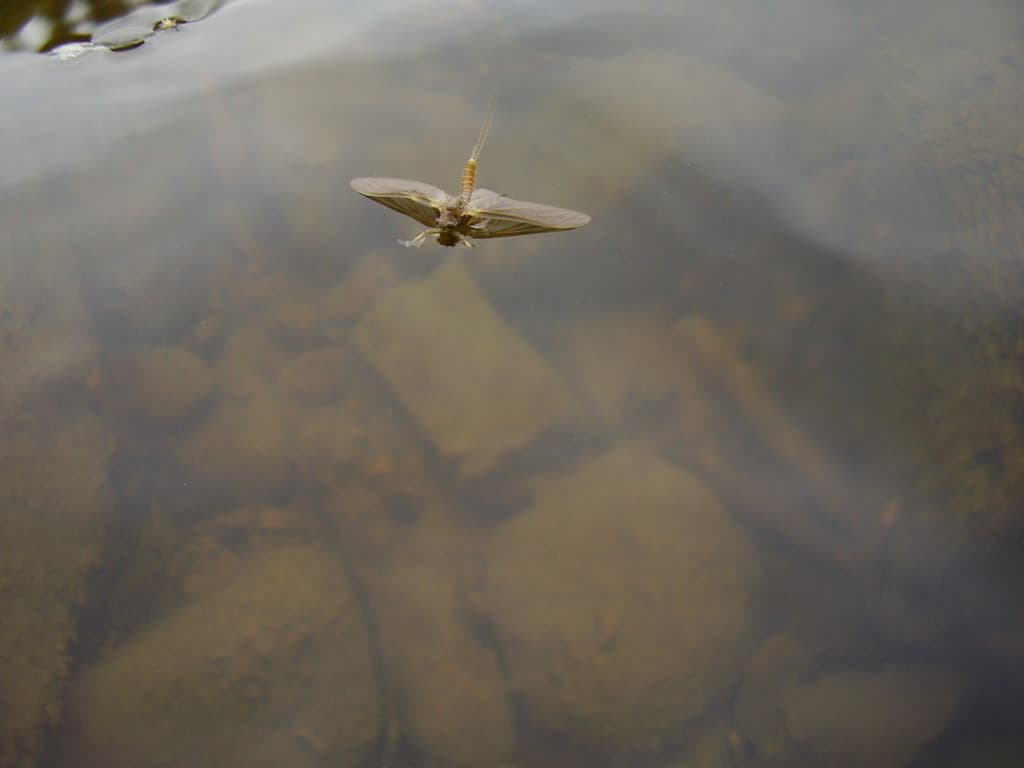
A dead drift means the fly is drifting naturally with the surface current and is not being pulled in an unnatural way.
The dead drift method is most likely going to produce the biggest fish but not necessarily the most fish.
With the dead drift method, you cast your fly just upstream and about 3 to 5 feet in front of a fish that you’ve seen rising.
Remember, trout and steelhead mostly face upriver and into the current so you need to land your fly accordingly.
If done right, your dry fly will drift naturally into the trout’s strike zone without dragging or being pulled by the current or the leader line, and hopefully, the fish will take the fly.
Be careful not to cast your fly line or float your fly line and leader over the fish as this could spook the fish and stop it from feeding.
This takes skill in both the fly cast and the presentation because if you make a mistake it can stop the fish from feeding.
BIG FISH FEEDING HABITS
Larger fish will often move into the best feeding lanes and wait for the insects to drift over their head and then rise up and eat them. As a fly angler, you want to replicate this with our own flies.
Often the bigger the natural insects are and the more abundant they are the more it will entice a big fish to come to the surface, and that will improve your chances.
Big insects can mean big trout and for many anglers, this is the best time to be on the water and dry fly fishing.
Even big steelhead will sometimes rise up for dry flies under the right conditions which can usually occur in late spring and early summer if the steelhead are still in the river.
GETTING THE DRIFT RIGHT
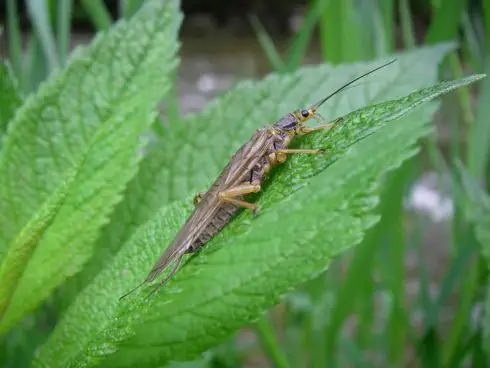
Brown trout are more likely to refuse a fly if the presentation isn’t perfect or be spooked by a mistake, but brook trout and rainbows are a little more forgiving and are better for beginners to learn on.
Drag can be a dry fly fisherman’s worst enemy so it’s important to learn to get a drag-free drift or the dead drift.
Drag happens when the current pulls the line which then pulls the fly making it move in a direction or at a speed that is not natural.
Any pulling by the current of the fly line close to the fish can indicate danger to the fish and prevent the fish from eating the fly, and in some cases, it will stop the fish from eating anything for a while.
DRY FLY ACTION
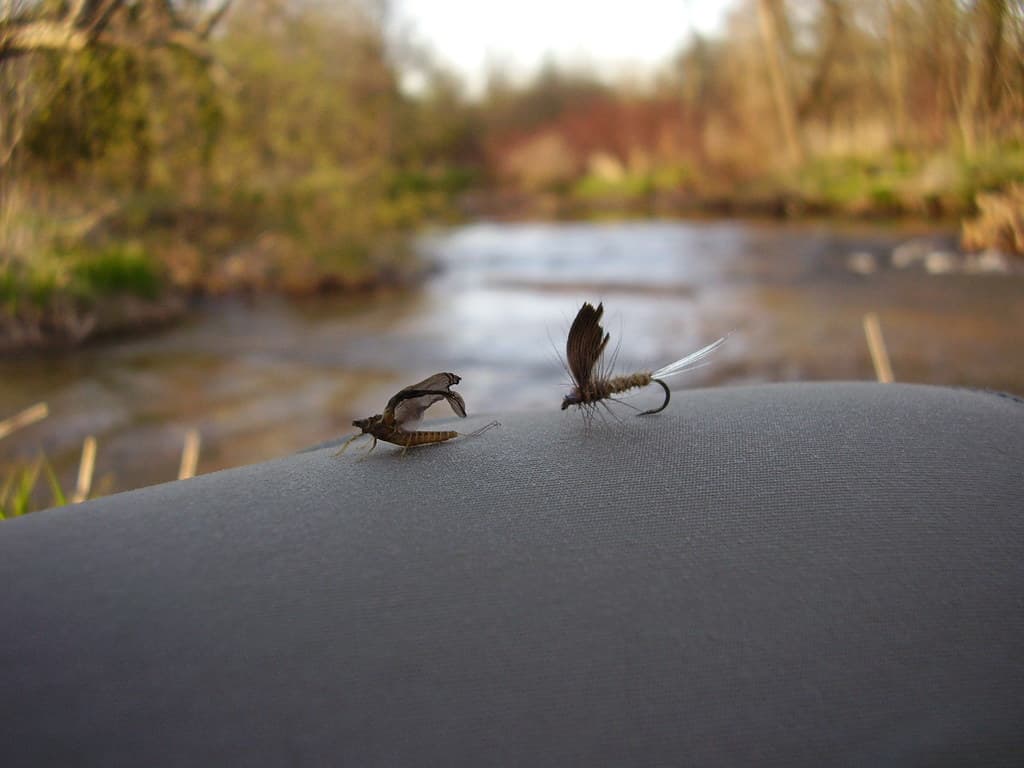
The other common method of dry fly fishing is the skittering or twitching method which is used in faster waters and for smaller aggressive trout.
With this method, you use a short tight line and with a light twitching or bouncing of the rod tip, you impart action to the fly trying to make it skitter, bouncing and twitching its way across the current which will hopefully entice a fish to hit the fly.
With this method, you’re trying to imitate a real insect that has dried its wings and is trying to get off the surface as it’s learning to fly or as the wind blows it across or down the river.
This method often gets fast aggressive hits from smaller fish since it’s a faster-moving fly and the trout has to move fast to grab it. This makes this method an exciting and very fun way to fish.
When I teach kids or even fish with my own kids this is the method that I usually use. The video link here is a good description of dry fly fishing. Watch Dry Fly Video.
Best Dry Flies For Ontario Trout
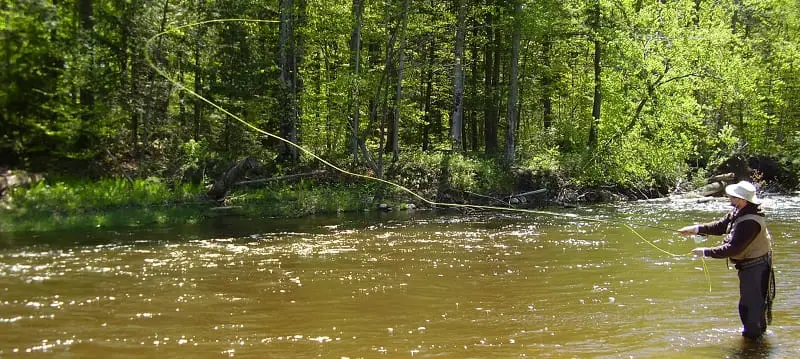
Trying to pick the best dry flies for fly fishing in Ontario is difficult due to the abundance of different aquatic flies on all the different rivers.
What flies should I use?
When I teach new anglers I often tell them not to get overwhelmed or discouraged when it come to choosing the right flies.
I tell them when you arrive at the river look at what flies are in the air and what flies you see on the water and then try to match the size, shape, and color to what is in your box. If you don’t have an exact match just find something close.
Back eddies or slow sections along the river banks will often collect some insects and it can be a good place to see what’s hatching.
A local Ontario hatch chart is good to look at before you go fly fishing in Ontario so that you have a decent idea of what you might expect for that time of year. Once you have an idea of what flies should be on the rivers, then you can buy some of the flies that match the hatch charts before you hit the river.
These are common dry flies that I would use often.
- The Royal Coachman fly is a good attractor pattern and one of my favorites for brook trout. Try size 12, 14, and 16.
- Elk Hair Caddis in size 16 and 18 is a must-have fly
- The Adams is another good all-around dry fly
- The Rusty Spinner is the fly you want for evening fishing
These are just generic examples of dry flies but tying your own flies are getting custom flies tied means better quality and a better match to the real thing. One of the best local Ontario places to get flies is ReelFlies.ca.
I also highly recommend the local fly shops because they primarily sell flies from our local rivers and you can get some great advice on what is happening on the rivers.
The Wet Fly Swing
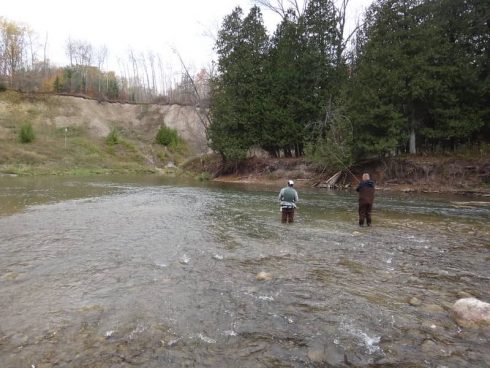
The Wet Fly Swing: Wet fly fishing is not as common as dry fly fishing or nymphing although under the right conditions, it can be extremely effective and fun for trout and steelhead.
Anglers will cast their sinking wet fly on a 45 degree angle downriver and maintain a tight line as the fly swings across the pool from the far side through the run or pool to directly below the angler or until it’s out of the strike zone.
Once the swing is complete the angler either moves down a foot or 2 or adds a foot of line and then repeats the process. This methods present the fly to a lot of fish but is often most productive for smaller or very aggressive fish.
The take or hit or “yank” as some call it is often a fast hard pull due to the tight line from the rod tip to the fly and this yank is part of the appeal to this method.
Any single hand fly rod in the 7 to 9-foot range and in the 3 to 6 weight size would be good for this technique. The fly lines used could be a floating or sinking line with a standard leader.
Some anglers may even choose a slow sink tip fly line or sinking leader like Airflo’s Poly Leader to help them keep the fly down and in the strike zone.
Check out the Video on Wet Fly Fishing and to learn more advanced wet fly fishing first hand from the guides at A Perfect Drift Guide Company.
Nymphing
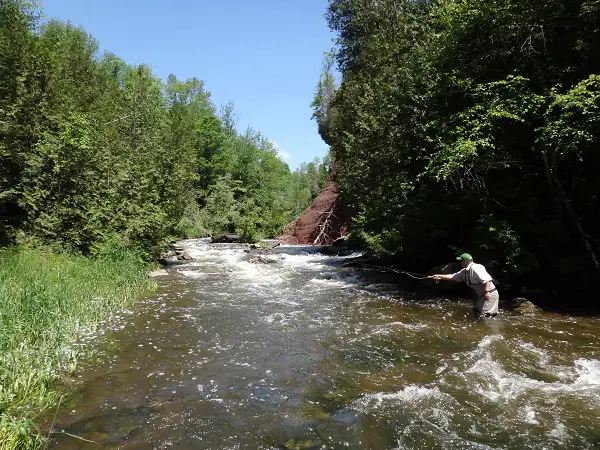
Nymphing for Trout: Nymphing for trout and steelhead is my specialty and for good reason. If done right it’s likely the most productive way to catch trout and steelhead in a river.
Nymphing is when you use flies that imitate the larval or underwater stages of insects and we call them nymphs.
Nymphs can also just be sunken food sources like a worm, or fish eggs, or a sunken beetle. The best thing about nymphing is that it can be done 12 months a year and you can nymph for trout, steelhead, bass, and salmon.
One of the reasons Nymphing is so productive is because trout feed below the surface over 90% of the time so it just makes sense to give them what they are used to.
Advanced Nymph fishing can be very technical with many variations for all the different situations and water types that anglers face.
Good nymph anglers will often out-produce all other fly fishing methods and an expert nymph angler will have far more skills than expert anglers using other fly fishing methods.
Best Nymphs For Ontario Trout
What are the best nymphs for Ontario Trout?
I recommend having a few attractor nymphs and a few imitation nymphs in various sizes. Most of the nymphs I use from trout are size 14 to 18 and for steelhead, I will use a size 8 to 12. If
Attractor nymphs might include Prince Nymphs, Rainbow Warrior,
Imitation Nymphs might Include: Stonefly Nymph, Hairs Ear Stonefly nymph, Pheasant Tail nymph, and caddis larva.
I’ve said this many times that if I had to choose 2 flies for all my trout fishing it would be a Pheasant tail nymph which resembles the many Mayfly and Stoneflies found in our rivers and a San Juan Worm.
Nymphing Rig For Fly Fishing In Ontario
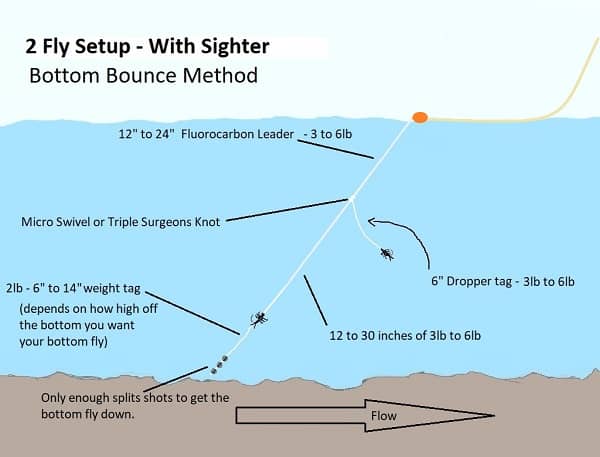
When I’m fly fishing I like to nymph and this is the fly fishing leader setup that I use.
This is the same leader that I use when I guide anglers and it can be used in fast and slow water.
I also use a very productive nymphing method called Euro Nymphing and I highly recommend that you check it out on my new blog at Euro Nymphing: An Expert Euro Guide Explains. See at www.troutandsteelhead.net
Knowing these methods will greatly improve your chances of catching fish when fly fishing in Ontario
Ontario Fly Fishing Rivers
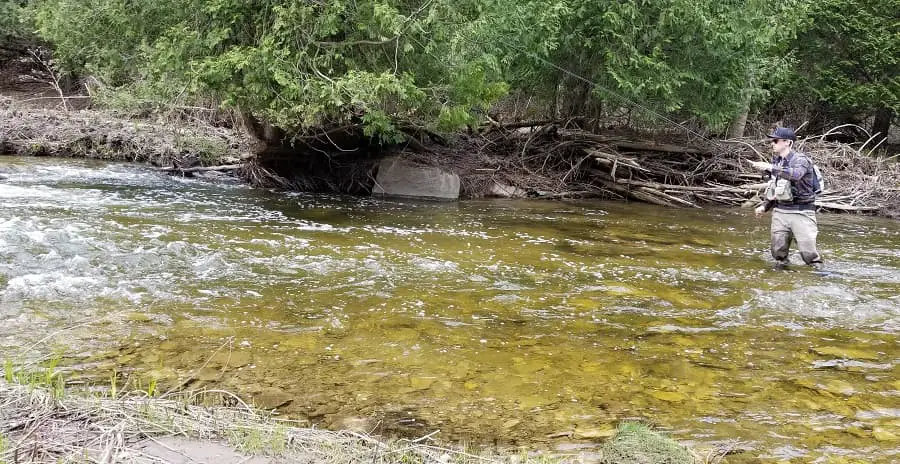
There are a lot of trout and steelhead and salmon rivers that you can choose from if you want to go fly fishing.
I have recently added a bunch of pages that list dozens of good rivers for fly fishing in Ontario. You can check them out on our rivers page.
Fly Fishing In Ontario Summary
That concludes my article on fly fishing in Ontario. I hope that helps you and gives you some ideas for future fishing trips.

